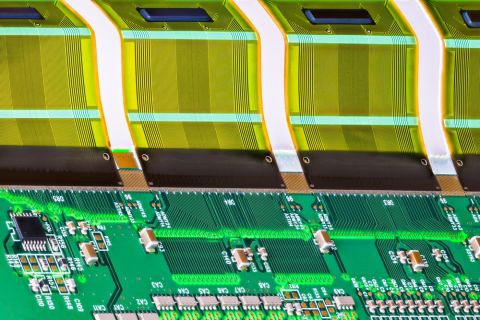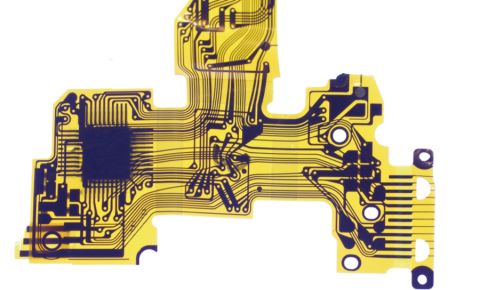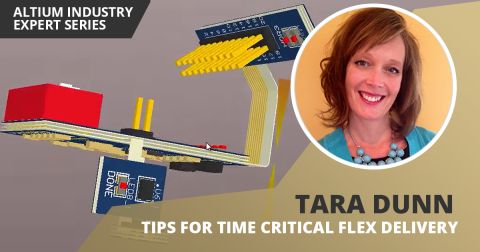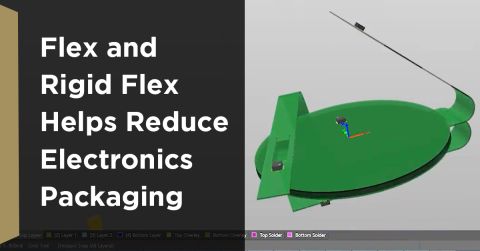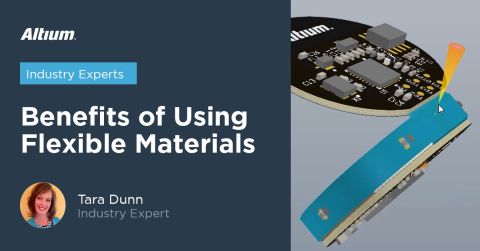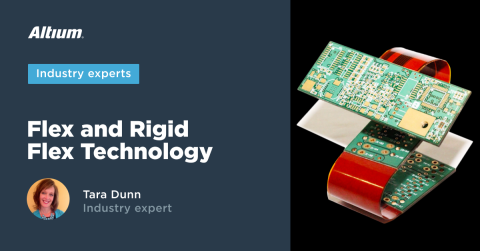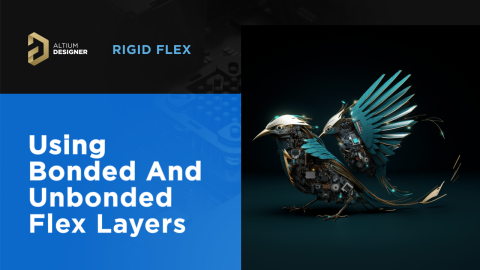Preparing Rigid-Flex PCB Documentation for Manufacturing

Anytime you design a new product that will be manufactured at scale, your job suddenly shifts from knowing everything about the design to knowing everything about the manufacturing process. You'll have one last set of tasks to complete before your job as a designer is complete: prepare the manufacturing documentation your manufacturer needs to begin production on your rigid-flex circuit board. For rigid-flex, the fabrication concerns and expectations are a bit different from those expected in rigid PCBs. In the coming sections, we'll provide some of the information you should specify in your fabrication documentation, specifically in your fabrication notes and drawings so that you can prevent misunderstandings when you transition to production.
Documenting Your Flex PCB for Manufacturing and Assembly
When you're preparing documentation, you're essentially telling the fabricator what you want to see in the rigid-flex assembly; it’s the most likely part of the process where errors or misunderstandings can cause costly delays. Fortunately, there are standards we can reference to make sure we are communicating clearly to the fabricator, in particular IPC-2223B (which I am referencing in writing this).
It could boil down to a few golden rules:
- Make sure your fabricator is capable of building your rigid-flex design.
- Make sure they collaborate with you on designing your layer stack to fit their particular processes.
- Use IPC-2223 as your point of reference for design, making sure the fabricator uses the same & related IPC standards - so they are using the same terminology as you.
- Involve them as early as possible in the process.
Careful attention needs to be paid to layer pair planning and documentation for drilling and through-hole plating, because blind vias from a rigid surface layer down to an opposing flex-circuit layer will have to be back-drilled and add significant cost and lower yield to the fab process.
Output Data Set
In interviewing a handful of rigid-flex capable board houses locally, we found that many designers still present Gerber files to the board house. However, ODB++ v8.1 or later is preferred, since it has specific layer types added to the job matrix that enable clear flex- documentation for GenFlex® and similar CAM tools. A subset of the data included is shown in the following table.
|
Layer Type |
Base Type |
Description |
|
Coverlay |
solder_mask |
Clearances of a coverlay layer |
|
Covercoat |
solder_mask |
Clearances of a covercoat layer |
|
Punch |
route |
Pattern for die-punching of the flex |
|
Stiffener |
mask |
Shapes and locations of stiffeners to be adhered |
|
Bend Area |
mask |
Labelling of areas that will be bent while in use |
|
PSA |
mask |
Pressure Sensitive Adhesive shapes and locations |
|
Area |
document |
An area definition (Rigid, Flex, or arbitrary) |
|
Exposed Area |
document |
An exposed area of an inner layer and it’s associated coverlay (could also be used for embedded components) |
|
Signal Flex |
signal |
A signal layer for a flex |
|
Power Ground Flex |
pg |
A power of ground layer for a flex |
|
Mixed Flex |
mixed |
Mixed layer for a flex |
|
Plating_mask |
mask |
A mask for defining which areas within a layer should be masked off from plating process |
|
Immersion_Mask |
mask |
A mask for defining which areas within a layer should be masked off for immersion gold |
Subset of Layer Types in ODB++ (v8.1 and later) used for GenFlex [Source: ODB++ v8.1 Specification]
There are some issues we face if using Gerber for the output data set, or earlier versions of ODB++. Namely, the fabricator will need separate route tool paths and die cut patterns for each rigid and flex section in the layer stack. Effectively, mechanical layer films would need to be produced to show where voids need to be in the rigid areas, and more to show where coverlay or covercoat will be on the exposed flex areas. The coverlay or covercoat also has to be considered a mask for component pads for those components that may be mounted on flex areas.
In addition, careful attention needs to be paid to layer pairs for drilling and through-hole plating, because blind vias from a rigid surface layer down to an opposing flex- layer will have to be back-drilled and add significant cost and lower yield to the fab process.
As a designer, the question is really then, how can I define these areas, layers and stacks?
Define the Stack by Area Using a Table
The most important documentation you can provide your fabricator is arguably the layer stack design. Along with this, if you’re doing rigid-flex, you have to provide different stacks for different areas, and somehow mark those very clearly. A simple way to do this is make a copy of your board outline on a mechanical layer, and lay down a layer stack table or diagram with a pattern-fill legend for the regions containing the different layer stacks. An example of this is shown below.

An example of a stack diagram showing fill patterns for rigid and flex areas.
In this example, I used matching fill patterns for different stack areas to indicate which stackup layers are included in the Flexible part or the Rigid part. You can see here the layer item I named “Dielectric 1” is actually an FR-4 core, which could alternatively be considered a stiffener.
Conveying the PCB Design Intent
This poses a new problem, in that you also have to define in 2D space where bends and folds can be, and where you will allow components and other critical objects to cross the boundaries of rigid and flexible sections. This all needs to be indicated in a fabrication drawing, an assembly drawing, or both. A 3D image showing flexible and rigid areas will help the fabricator understand your intent more clearly. Many people do this currently with MCAD software, after having imported the STEP files of the PCB layout. The image below shows an example of this concept.
Creating some kind fo graphic from an MCAD application can have the added benefit of detecting flex-to-flex and flex-to-rigid interferences before fabrication. As is the case with Altium Designer, the online Design Rule Checker (DRC) interactively shows where interferences occur. When it comes to final product assembly, it is even more desirable to provide the assembly manager and staff with a 3D animated movie of how the rigid-flex board will fold for installation into the product enclosure or assembly. This is where having a screen capture or 3D movie straight for the CAD tool can be very helpful as part of the final assembly documentation package.

Example rigid-flex PCB in Altium Designer
Placement
You can see also from the image above, that rigid-flex designs imply that components might exist in layers other than top and bottom. This is a bit tricky in the PCB design software, because normally components must exist on top or bottom. So we need some ability to place components on inner layers.
Interestingly, Altium Designer® has always supported pad objects on any layer, so this is not impossible. There’s also an implication that silkscreen could exist on flex layers as well. This is not a problem, since coverlay material can adhere well to the silkscreen ink. The trick is more to make sure there’s adequate contrast for the color of ink chosen against the coverlay material. Also, resolution is affected since the ink has to traverse a small gap beyond the screen to land on the flex coverlay. Again, this is something that needs to be discussed with the fabricator to determine what’s possible and economical.
Note: If you’re going to the effort of drawing the regions of the PCB which are exposed flex layers, and placing components on those regions, this also makes a reasonable method for placing embedded components into cutout regions of the board. You need to generate a set of very clear documents that show where the cutouts are and in which sections of the layer stack they apply. This is going to be limited depending on the fabricators methods - either back-drilling or multiple laminated stack-ups can be used. So communicating your intent and minimizing the number of separate cutout stack sections is important. It’s best to completely avoid having intersecting cutouts from opposite sides of the board.
Conventional wisdom calls for stiffeners or rigid sections where components will be mounted on flex anyway for dynamic applications. This is to prevent dry solder joints and copper cracks due to fatigue caused by circuit movement around rigid component pins. In some circumstances, this is not necessary because the flexible region will be installed into a fixed backing alongside the rest of the board, thereafter it will be static. This situation is referred to in IPC-2223 as ‘Flex to Install’.
Creating Documentation
Documentation for rigid flex PCBs, including fabrication and assembly drawings, is simple with an automated drawing utility inside your ECAD software. Some of the important points to document in your rigid-flex or flex fabrication drawing include:
- Dimensions for each region in the bare board
- A stackup drawing that shows all materials and layer arrangements
- A drill table with hole sizes and tolerances
- An impedance table if controlled impedance is required
- Component outlines for major parts with reference designators
- Complete fabrication and assembly notes

You can speed your way through the rigid-flex documentation process with the complete set of CAD features and automated drawing tools in the Draftsman package inside Altium Designer®. Once you're ready to release your design data to your manufacturer, you can easily share and collaborate on your designs through the Altium 365™ platform. Everything you need to design and produce advanced electronics can be found in one software package.
We have only scratched the surface of what is possible to do with Altium Designer on Altium 365. Start your free trial of Altium Designer + Altium 365 today.
